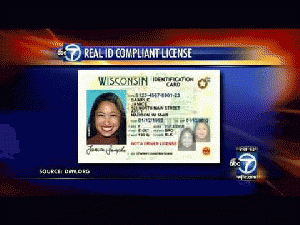Reprinted from WSWS
Driver's licenses from at least nine states are likely to be rejected as identification for the purpose of air travel in the United States, according to reports citing officials in the Department of Homeland Security and the Transportation Security Administration. The DHS and TSA are moving toward enforcing the 10-year-old Real ID Act that sets down strict federal requirements for state-issued driver's licenses.
Among other things, the Real ID Act requires that applicants for state licenses provide documentation of their identity, including Social Security number and immigration status, and that the licenses issued have "machine readable" technology such as a chip or bar code that stores personal information in electronic form.
Most states have either failed to issue licenses that conform to the Real ID Act or have flatly refused to do so out of concern that such standardized licenses would become a de facto national ID card. The TSA has issued a series of waivers, allowing passengers to use state driver's licenses as ID for the purposes of air travel, but the waivers for nine states are set to expire January 10, 2016. Those states are Alaska, California, Illinois, Minnesota, Missouri, New Jersey, New Mexico, South Carolina and Washington. The total population of these nine states is 90 million people, according to the most recent Census estimates.
Passengers holding driver's licenses from those states would not be immediately barred from flights, but the TSA is expected to issue guidance starting a 120-day clock, meaning those passengers would have to show a passport to travel within the United States beginning sometime in May. Since nearly two-thirds of US citizens have not obtained passports, such a requirement could bar 50 to 60 million Americans from flying.
Another 19 states will have waiver extensions from the TSA expiring later in 2016 -- New Hampshire on June 1 and the remaining 18 on October 10. These 18 states include Arizona, Arkansas, Idaho, Kentucky, Louisiana, Maine, Massachusetts, Michigan, Montana, New York, North Carolina, North Dakota, Oklahoma, Oregon, Pennsylvania, Rhode Island, Texas and Virginia. The combined population of the 28 states that are not in compliance with Real ID comes to 217 million people, more than two-thirds of the US population.
Five US territories, Guam, Puerto Rico, the Virgin Islands, the Northern Mariana Islands and American Samoa, whose citizens generally fly to travel because they live on remote islands, are also non-compliant with Real ID and face the expiration of extensions in 2016.
The Real ID Act was passed in 2005 during the Bush administration, one of a series of new security laws, such as the Patriot Act, adopted in the wake of the terrorist attacks of September 11, 2001. Many of the suicide hijackers on 9/11 used state-issued driver's licenses as identification to buy one-way tickets and board their flights, and the 9/11 Commission, which whitewashed the role of the security agencies, particularly the CIA and NSA, in facilitating the terrorist attacks singled out driver's licenses as a key area for "reform."
There was persistent opposition from state governments to the new federal requirements on state driver's licenses, in part on grounds of civil liberties and opposition from immigrants' rights groups, in part because of the additional costs imposed on state budgets to produce the more expensive forms of ID, including an embedded computer chip. A majority of states have either passed laws prohibiting their departments of motor vehicles from enforcing Real ID or passed resolutions of disapproval.
A particular concern cited by privacy and civil liberties groups is that Real ID would transform state-issued driver's licenses into the equivalent of a national identification card, which has never existed in the United States. The federal government has no legal or constitutional authority to create or require such a national ID card, but the enforcement of Real ID on state driver's licenses serves as a backdoor method for introducing it.
In the aftermath of the Paris and San Bernardino attacks, there is a new push by the US military-intelligence apparatus to expand its powers and crack down on the democratic rights of the American people. Even before these two events, in October, according to the New York Times, the federal government "began requiring that visitors to military bases, nuclear plants and federal facilities produce a driver's license from a state that complies with the law, or show another form of government ID, like a passport."
The new driver's licenses would encode a considerable amount of personal information in an electronic form that would be shared among the states and with the federal government, assisting in the creation of vast new databases on the American population. These could be used to track people's movements, not only by air but also on the ground, using the chip in the card. The chip is also susceptible to hacking by anyone with the requisite skills and equipment, leading to the nightmare prospect of people's personal identification information being stolen as they walked down the street, since many of the chips are readable from as far away as 30 feet.





